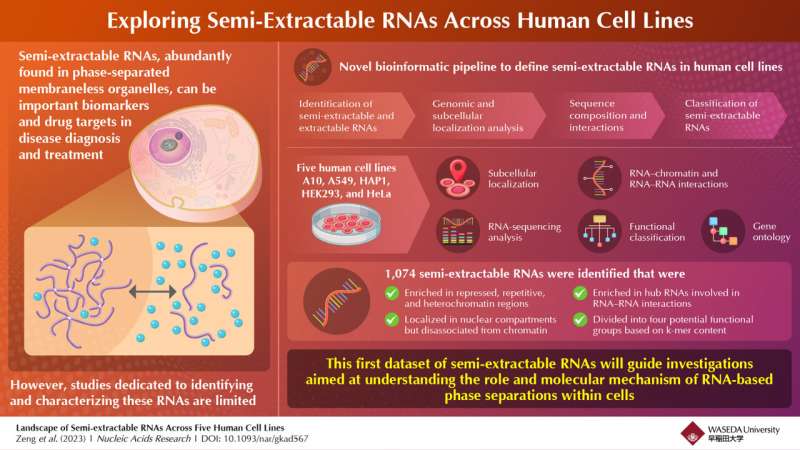This article has been reviewed according to Science X's editorial process and policies. Editors have highlighted the following attributes while ensuring the content's credibility:
fact-checked
peer-reviewed publication
trusted source
proofread
Unraveling the mystery of semi-extractable RNAs from human cell lines

Membraneless organelles (MLOs), also known as "biomolecular condensates," are formed by the biological process of liquid-liquid phase separation (LLPS). MLOs are highly dynamic bodies containing proteins and nucleic acids.
While the role of proteins in LLPS has been extensively investigated, there is a growing interest in the scientific community to understand the role of RNAs—the nucleic acid responsible for innumerable biological functions including coding, decoding, regulation, and expression of genes, and ultimately proteins—in phase separation.
Recent studies have revealed that MLOs are rich in RNAs that are poorly extracted by conventional methods but can be efficiently recovered using improved methods like needle shearing and heating, a property known as semi-extractability. These semi-extractable RNAs can be important biomarkers and drug targets in disease diagnosis and treatment. However, very few studies have succeeded in identifying and characterizing these RNAs.
To address this gap, Dr. Chao Zeng, assistant professor at Waseda University, in collaboration with Dr. Michiaki Hamada from Waseda University, Dr. Takeshi Chujo from Kumamoto University, and Dr. Tetsuro Hirose from Osaka University, have developed a novel bioinformatic pipeline to define semi-extractable RNAs across human cell lines. Their findings were published in the journal Nucleic Acids Research on July 19, 2023.
The team performed cellular RNA extraction and sequencing on five human cell lines, namely, A10, A549, HEK293, HeLa, and HAP1 cells. They further analyzed the RNA sequencing data using various computational methods. Differential expression analysis was performed between samples extracted using the conventional RNA extraction method and the improved extraction method. The researchers identified RNA transcripts that were consistently semi-extractable in all five cell lines.
Repeat density and sequence motif analysis were also conducted to explore potential factors influencing semi-extractability. Additionally, the researchers performed k-mer analysis using the SEEKR algorithm to functionally classify semi-extractable RNAs based on their k-mer content.
Sharing the highlight of their study, Chao Zeng explains, "Using the newly developed bioinformatic analysis pipeline, we examined original experimental data from cultured human cell types and successfully identified and characterized 1,074 semi-extractable RNAs potentially involved in the formation of phase-separated membraneless organelles."
Upon investigating the localization of semi-extractable RNAs in chromatin as well as within the cell, the team found that these RNAs were enriched in repressed and repetitive heterochromatin (darkly staining) regions, especially in Polycomb-repressed areas. Inside the cells, the RNAs were concentrated in the nucleus, including the nucleolus, but disassociated from the chromatin.
Additionally, the researchers postulated that the semi-extractable RNAs could potentially function as a platform for interacting with other RNAs. To verify their hypothesis, they compared semi-extractable RNAs with close to 600 hub RNAs forming protein-mediated RNA-RNA interactions with multiple other RNAs. They found that semi-extractable RNAs indeed acted as hubs and were pivotal in forming RNA-RNA interactions.
Further analysis of semi-extractable RNA revealed a marked preference of RNA-binding proteins in binding to AU-rich regions associated with the RNAs. While messenger RNAs typically exhibit the AU-rich regions at the 3' end, which regulates RNA stability, semi-extractable RNAs exhibited a concentration of AU regions at the 5' end, indicating potential involvement in undiscovered functions.
The study provides the first dataset of semi-extractable RNAs across human cell lines, which is a valuable resource for investigating RNA-based phase separations. "Future integration of semi-extractable RNAs with RNA interaction studies will provide insights into the molecular mechanisms underlying RNA-induced phase separation in cells," concludes Michiaki Hamada.
The study findings provide new perspectives to explore the involvement of RNA in biological processes such as cancer development and progression, viral RNA degradation, and cellular stress responses, and can drive the development of therapeutic strategies for cancer and infectious diseases.
More information: Chao Zeng et al, Landscape of semi-extractable RNAs across five human cell lines, Nucleic Acids Research (2023). DOI: 10.1093/nar/gkad567
Journal information: Nucleic Acids Research
Provided by Waseda University



















